ssm-mybatis进阶之动态sql
ssm-mybatis进阶之动态sql
动态 SQL 是 MyBatis 的强大特性之一。如果你使用过 JDBC 或其它类似的框架,你应该能理解根据不同条件拼接 SQL 语句有多痛苦,
例如拼接时要确保不能忘记添加必要的空格,还要注意去掉列表最后一个列名的逗号。利用动态 SQL,可以彻底摆脱这种痛苦。MyBatis
动态 SQL 主要通过在mapper映射文件中,使用类似于JSTL语言进行编写。
动态SQL元素
MyBatis 3 之后,元素已经大大精简,主要有以下几种:
- if
- choose (when, otherwise)
- trim (where, set)
- foreach
if
使用动态 SQL 最常见情景是根据条件包含 where 子句的一部分,下面举例说明:
- 编写dao:
- 编写mapper映射文件:
- 编写测试方法验证:
List<Student> getStudents(@Param("sex") String sex, @Param("pageIndex") int pageIndex, @Param("pageSize") int pageSize);

语法:<if test=”条件表达式”>拼接sql语句</if>
@Test
public void getStudents() {
SqlSession sqlSession = MybatisUtils.getSqlSession();
StudentMapper mapper = sqlSession.getMapper(StudentMapper.class);
//不筛选性别,也不分页
List<Student> students = mapper.getStudents("", 0, 0);
Object jsonStr = JSON.toJSON(students);
System.out.println(jsonStr);
sqlSession.close();
} 不筛选性别,也不分页,结果如下:

修改测试方法,筛选性比也分页,验证如下:
List<Student> students = mapper.getStudents("男", 0, 2); 
choose (when, otherwise)
有时候,我们不想使用所有的条件,而只是想从多个条件中选择一个使用,Mybatis 又没提供 else 。
针对这种情况,MyBatis 提供了 choose 元素,它有点像 Java 中的 switch 语句。
- 编写dao:
- 编写mapper映射文件:
- 编写测试方法验证:
List<Student> getStudents2(@Param("sex") String sex, @Param("name") String name);
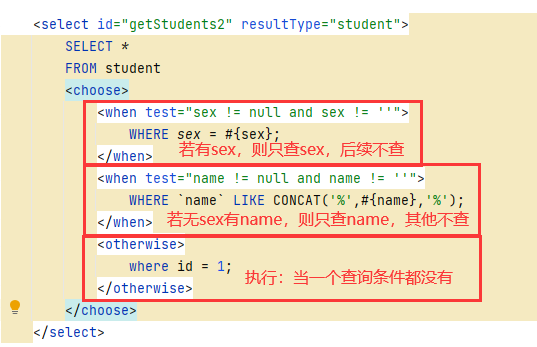
重点:要注意like语句的拼接方式
语法:
<choose>
<when test="条件表达式1">
拼接SQL1
</when>
<when test="条件表达式2">
拼接SQL2
</when>
...
<otherwise>
拼接默认SQL
</otherwise>
</choose>
@Test
public void getStudents2() {
SqlSession sqlSession = MybatisUtils.getSqlSession();
StudentMapper mapper = sqlSession.getMapper(StudentMapper.class);
//只执行性别筛选
List<Student> students = mapper.getStudents2("男", "");
Object jsonStr = JSON.toJSON(students);
System.out.println("[1]:" + jsonStr);
//只执行姓名筛选
students = mapper.getStudents2("", "张");
jsonStr = JSON.toJSON(students);
System.out.println("[2]:" + jsonStr);
//参数都传递,但只会按顺寻执行第一个筛选
students = mapper.getStudents2("女", "张");
jsonStr = JSON.toJSON(students);
System.out.println("[3]:" + jsonStr);
//一个都不传,默认返回第一个
students = mapper.getStudents2("", "");
jsonStr = JSON.toJSON(students);
System.out.println("[4]:" + jsonStr);
sqlSession.close();
} 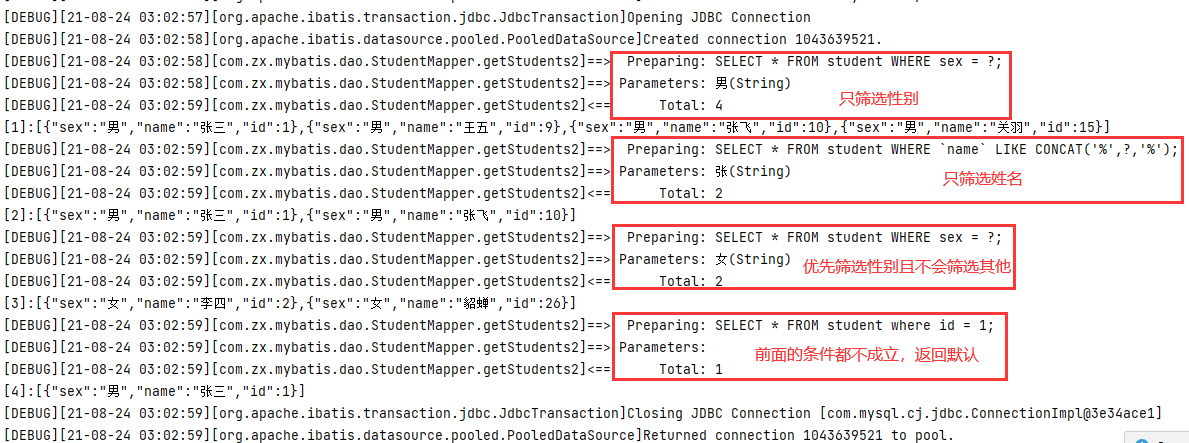
trim (where, set)
trim主要为了解决多条语句拼接时,冗余关键字、符号问题,MyBatis 已经提取了常用的去冗元素:<where>,<set>。
其中<where>标签主要解决拼接筛选过程中去除多余的AND和OR,<set>则解决赋值过程中多余的逗号问题。
下面就用<where>来举例说明(<set>类似)
- 编写dao:
- 编写mapper映射文件:
- 编写测试方法验证:
List<Student> getStudents3(@Param("sex") String sex, @Param("name") String name);
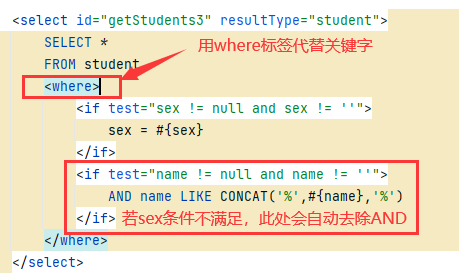
@Test
public void getStudents3() {
SqlSession sqlSession = MybatisUtils.getSqlSession();
StudentMapper mapper = sqlSession.getMapper(StudentMapper.class);
//只执行性别筛选
List<Student> students = mapper.getStudents3("男", "");
Object jsonStr = JSON.toJSON(students);
System.out.println("[1]:" + jsonStr);
//只执行姓名筛选
students = mapper.getStudents3("", "张");
jsonStr = JSON.toJSON(students);
System.out.println("[2]:" + jsonStr);
//参数都传递,都会筛选
students = mapper.getStudents3("女", "李");
jsonStr = JSON.toJSON(students);
System.out.println("[3]:" + jsonStr);
//一个都不传,返回所有
students = mapper.getStudents3("", "");
jsonStr = JSON.toJSON(students);
System.out.println("[4]:" + jsonStr);
sqlSession.close();
} 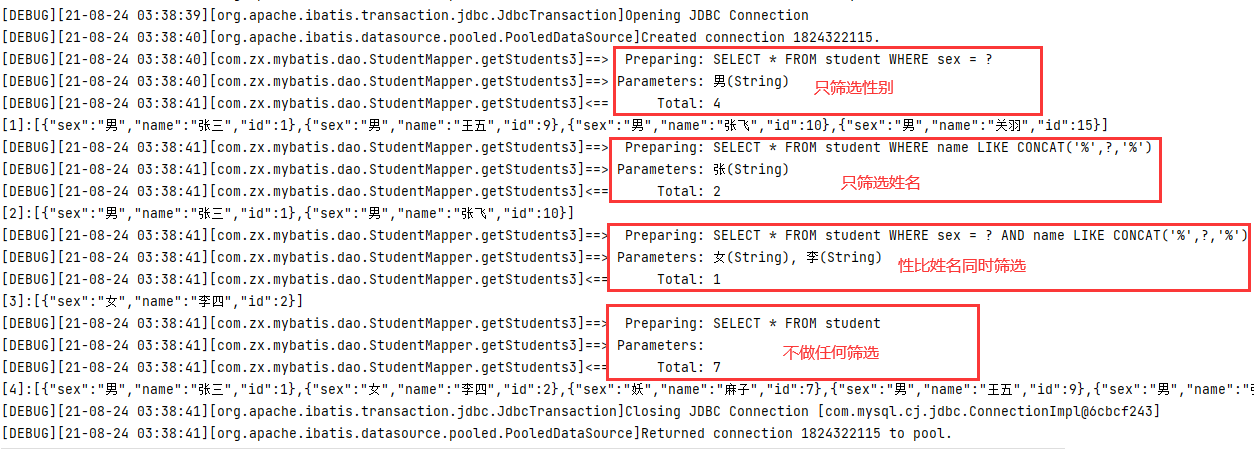
foreach
动态 SQL 的另一个常见使用场景是对集合进行遍历(尤其是在构建 IN 条件语句的时候)。
- 编写dao:
- 编写mapper映射文件:
- 编写测试方法验证:
List<Student> getStudentsForeach(@Param("sex") String sex, @Param("ids") int[] ids);
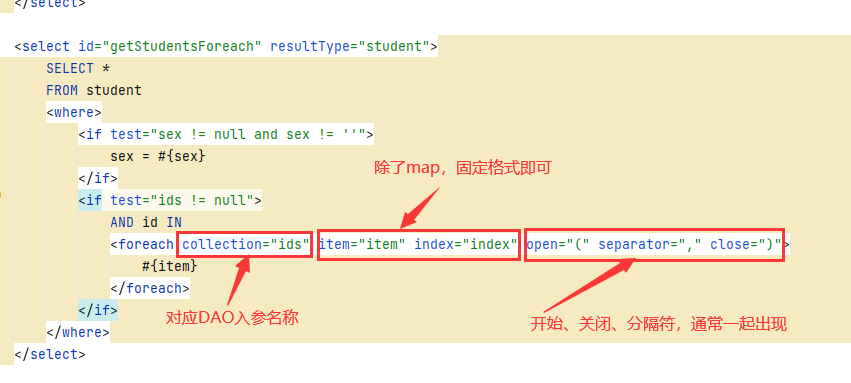
collection 可以是 list, set, array, map。map 时 index 为 key , item 为值。
@Test
public void getStudentsForeach() {
SqlSession sqlSession = MybatisUtils.getSqlSession();
StudentMapper mapper = sqlSession.getMapper(StudentMapper.class);
int[] ids = new int[]{1, 2, 3};
List<Student> students = mapper.getStudentsForeach("男", ids);
Object jsonStr = JSON.toJSON(students);
System.out.println(jsonStr);
sqlSession.close();
} 


